Abstract
A number of drugs classed as calcium antagonists, spasmolytics, non-specific receptor antagonists or receptor antagonists with multiple sites of action were tested to determine whether they prevent the stimulation of phosphatidylinositol turnover caused in various tissues by the activation of receptors which increase cell-surface Ca2+ permeability. The experiments were done with fragments of longitudinal smooth muscle from guinea-pig ileum; these were incubated in vitro with 32Pi and either 100 muM-carbamoylcholine or 100 muM-histamine, in the presence of antagonistic drugs at concentrations at least sufficient to cause complete blockade of smooth-muscle contraction. The phosphatidylinositol response to carbamoylcholine was not changed by cinchocaine, papaverine, nifedipine, dibenamine, amethocaine, cinnarizine, lidoflazine, methoxyverapamil, prenylamine or two antimuscarinic alkane-bis-ammonium compounds, and the response to histamine was unaffected by the first four drugs. In contrast, phenoxybenzamine prevented the increase in phosphatidylinositol labelling caused by either carbamoylcholine or histamine. The insensitivity of the phosphatidylinositol response to most of the drugs provides further experimental support for the conclusion that the receptor-stimulated phosphatidylinositol breakdown which initiates the increase in phosphatidylinositol turnover is not caused by an increase in intracellular Ca2+. The simplest interpretation of the available information appears to be that phosphatidylinositol breakdown plays a role in the coupling between the receptor-agonist interaction and the opening of cell-surface Ca2+ gates [Michell, R. H. (1975) Biochim. Biophys. Acta 415, 81-147]. If this is correct, then phenoxybenzamine must exert its inhibitory effects on phosphatidylinositol breakdown early in this sequence of events, but the drugs must act at a stage later than phosphatidylinositol breakdown. The unexpected difference in the effects of dibenamine and phenoxybenzamine, which are chemically very similar, may provide a useful experimental tool with which to explore the way in which activated receptors provoke the opening of cell-surface Ca2+ gates.
Full text
PDF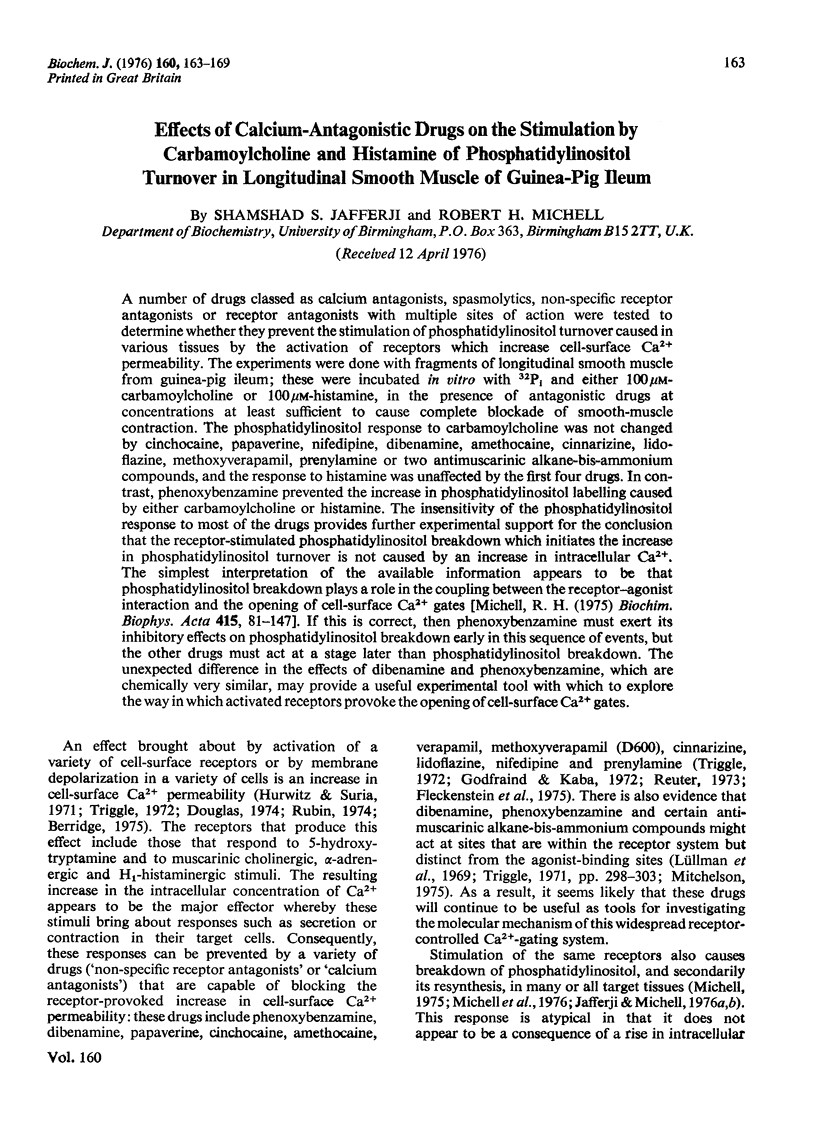
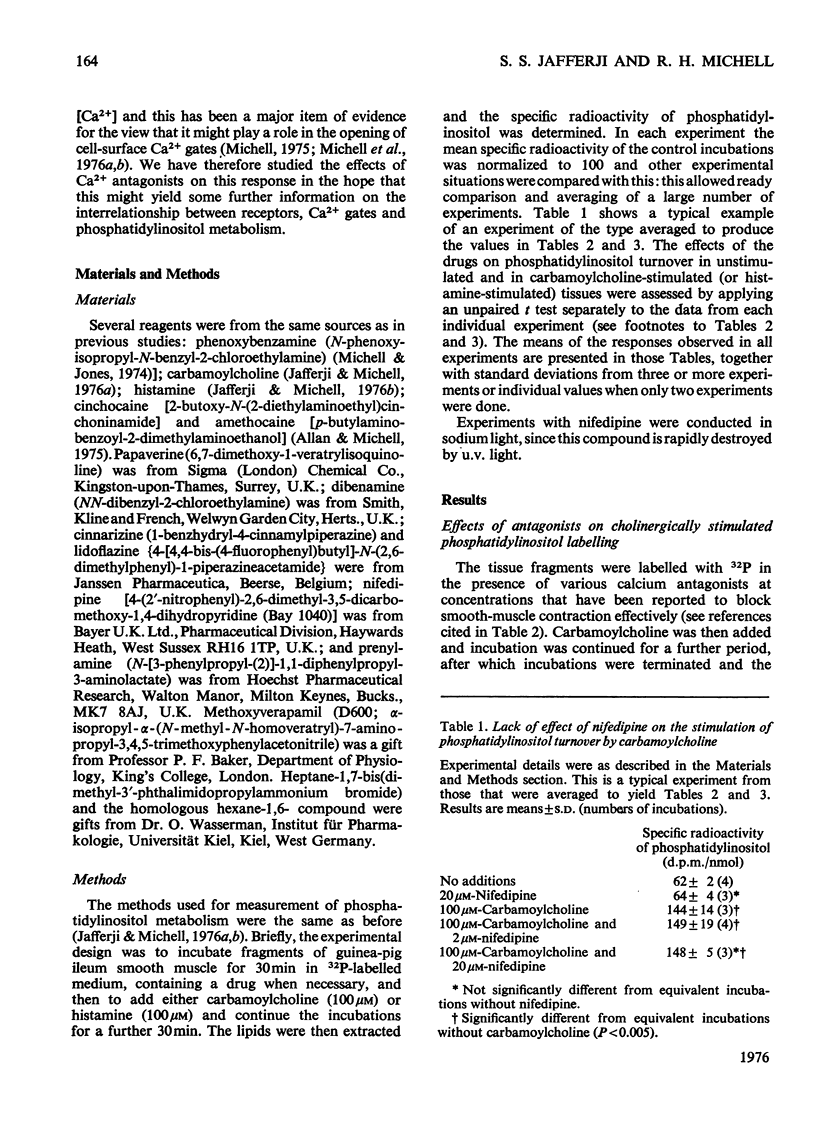
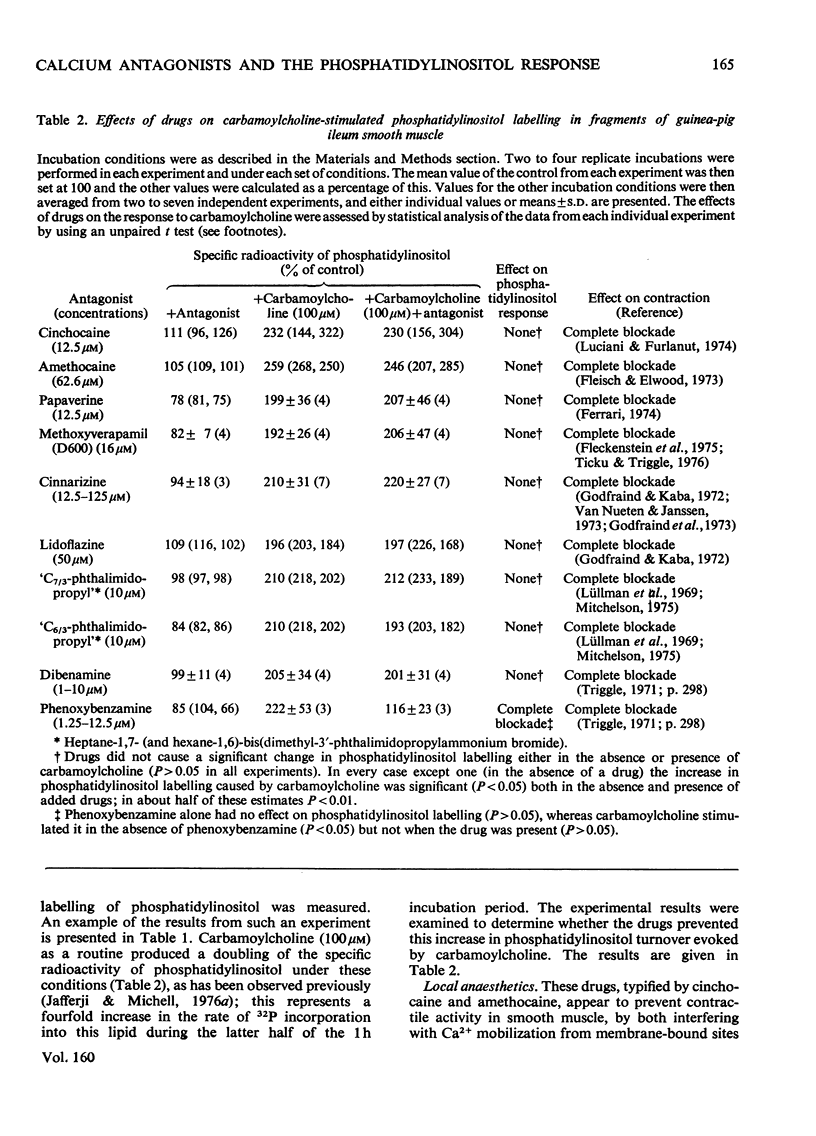

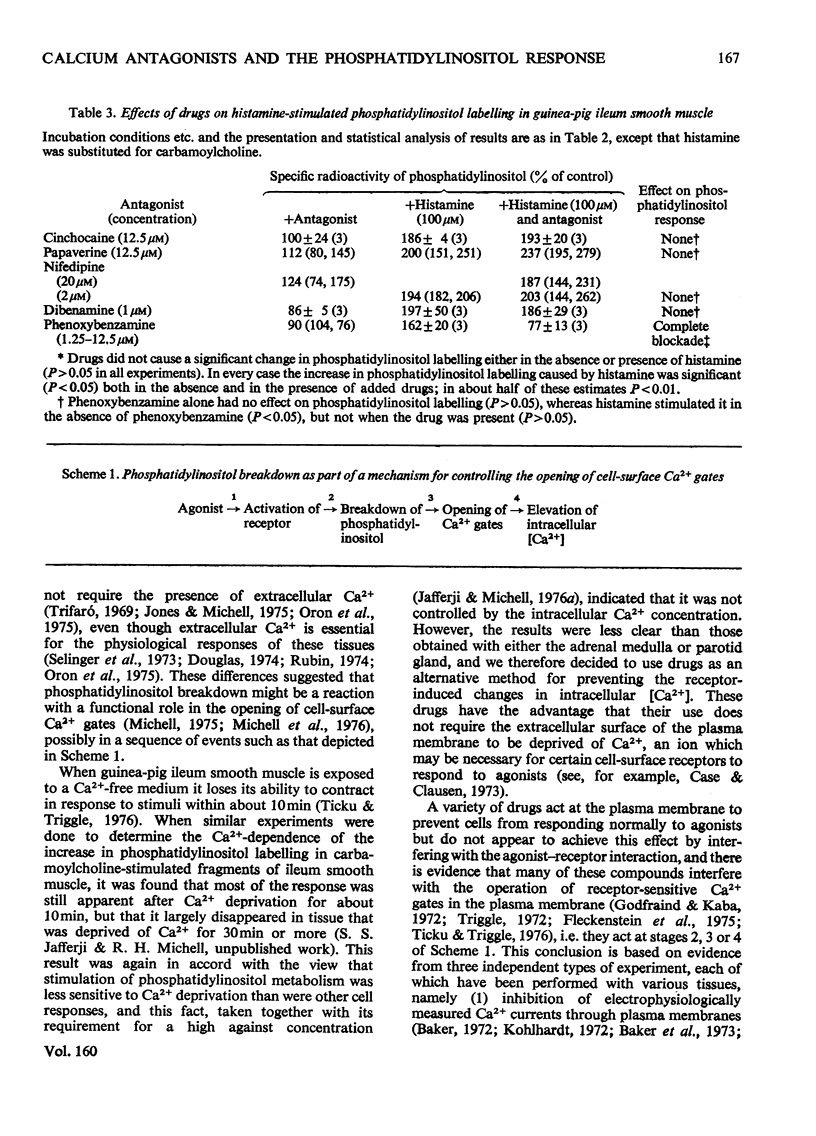
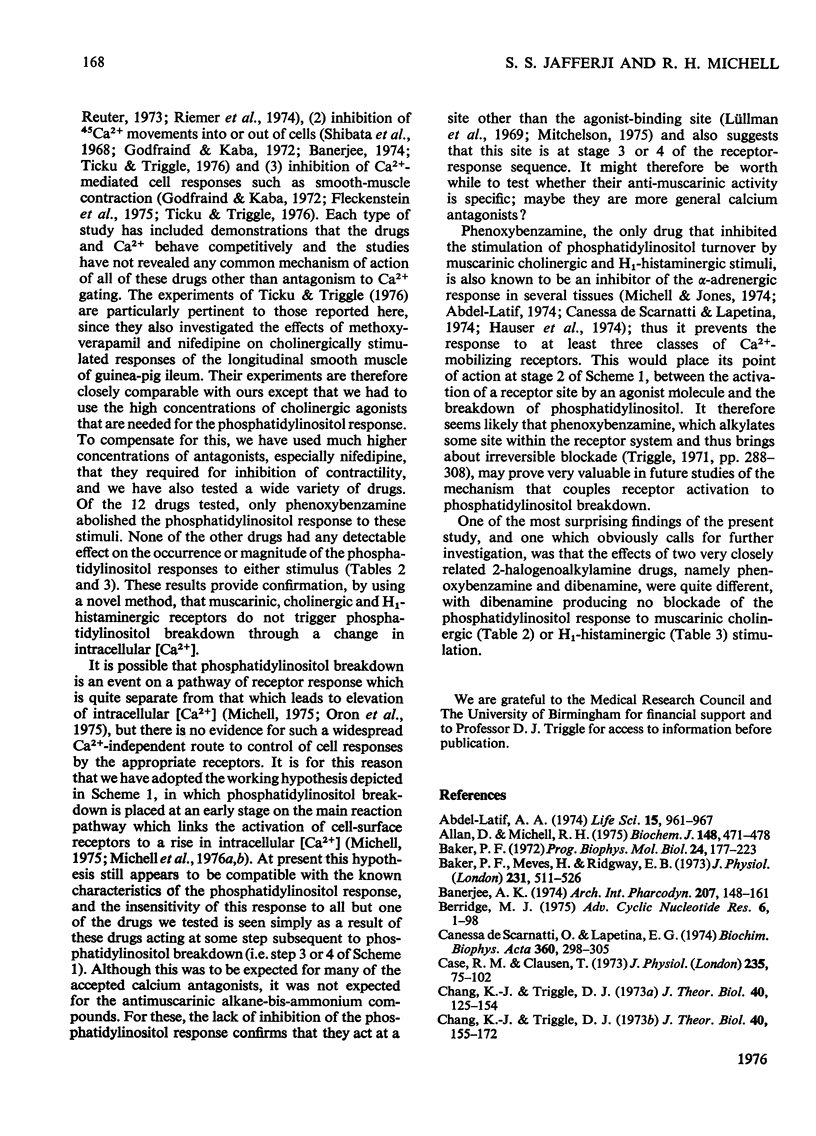
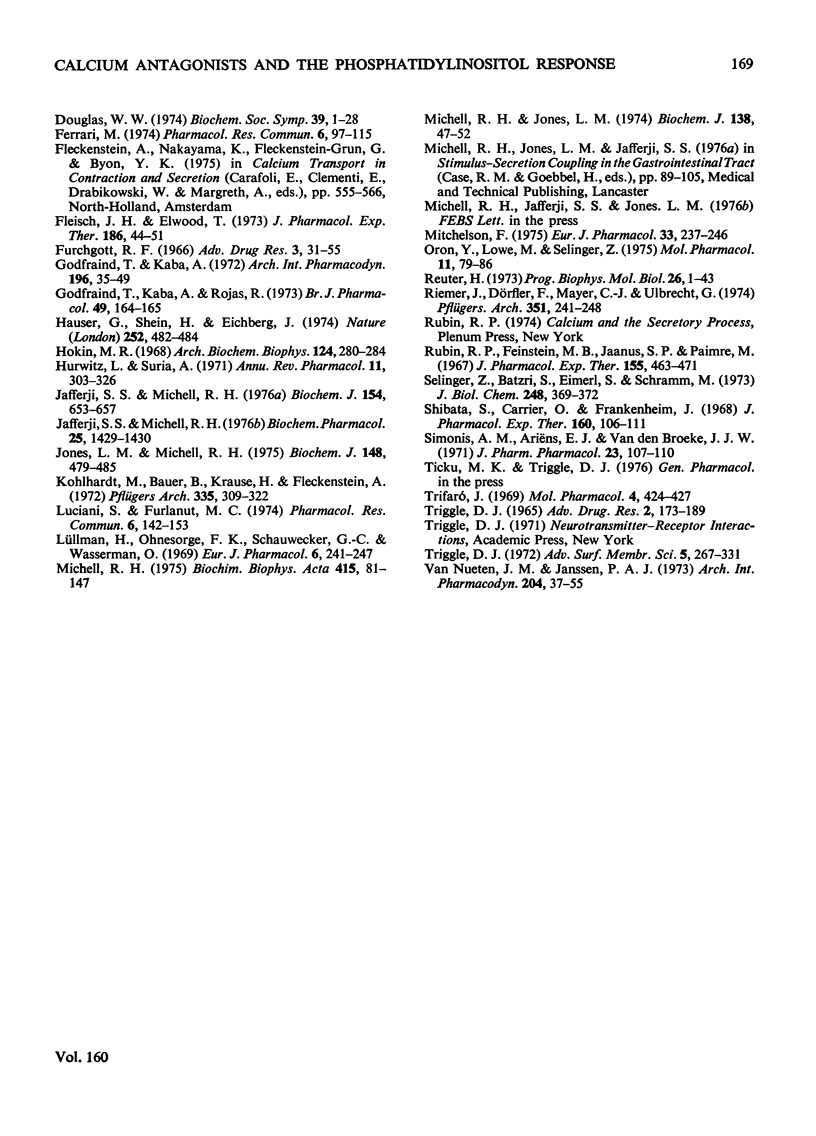
Selected References
These references are in PubMed. This may not be the complete list of references from this article.
- Abdel-Latif A. A. Effects of neurotransmitters and other pharmacological agents on 32Pi incorporation into phospholipids of the iris muscle of the rabbit. Life Sci. 1974 Sep 1;15(5):961–973. doi: 10.1016/0024-3205(74)90011-3. [DOI] [PubMed] [Google Scholar]
- Allan D., Michell R. H. Enhanced synthesis de novo of phosphatidylinositol in lymphocytes treated with cationic amphiphilic drugs. Biochem J. 1975 Jun;148(3):471–478. doi: 10.1042/bj1480471. [DOI] [PMC free article] [PubMed] [Google Scholar]
- Baker P. F., Meves H., Ridgway E. B. Effects of manganese and other agents on the calcium uptake that follows depolarization of squid axons. J Physiol. 1973 Jun;231(3):511–526. doi: 10.1113/jphysiol.1973.sp010246. [DOI] [PMC free article] [PubMed] [Google Scholar]
- Baker P. F. Transport and metabolism of calcium ions in nerve. Prog Biophys Mol Biol. 1972;24:177–223. doi: 10.1016/0079-6107(72)90007-7. [DOI] [PubMed] [Google Scholar]
- Banerjee A. K. Effects of drugs on 47Ca2+ movements in depolarized longitudinal smooth muscle. Arch Int Pharmacodyn Ther. 1974 Jan;207(1):148–161. [PubMed] [Google Scholar]
- Berridge M. J. The interaction of cyclic nucleotides and calcium in the control of cellular activity. Adv Cyclic Nucleotide Res. 1975;6:1–98. [PubMed] [Google Scholar]
- Canessa de Scarnati O., Lapetina E. G. Adrenergic stimulation of phosphatidylinositol labelling in rat vas deferens. Biochim Biophys Acta. 1974 Sep 19;360(3):298–305. doi: 10.1016/0005-2760(74)90059-9. [DOI] [PubMed] [Google Scholar]
- Case R. M., Clausen T. The relationship between calcium exchange and enzyme secretion in the isolated rat pancreas. J Physiol. 1973 Nov;235(1):75–102. doi: 10.1113/jphysiol.1973.sp010379. [DOI] [PMC free article] [PubMed] [Google Scholar]
- Chang K. J., Triggle D. J. Quantitative aspects of drug-receptor interactions. I. Ca2+ and cholinergic receptor activation in smooth muscle: a basic model for drug-receptor interactions. J Theor Biol. 1973 Jul;40(1):125–154. doi: 10.1016/0022-5193(73)90168-9. [DOI] [PubMed] [Google Scholar]
- Chang K. J., Triggle D. J. Quantitative aspects of drug-receptor interactions. II. The role of Ca2+men in desensitization and spasmolytic activity. J Theor Biol. 1973 Jul;40(1):155–172. doi: 10.1016/0022-5193(73)90169-0. [DOI] [PubMed] [Google Scholar]
- Douglas W. W. Involvement of calcium in exocytosis and the exocytosis--vesiculation sequence. Biochem Soc Symp. 1974;(39):1–28. [PubMed] [Google Scholar]
- Ferrari M. Effects of papaverine on smooth muscle and their mechanisms. Pharmacol Res Commun. 1974 Apr;6(2):97–115. doi: 10.1016/s0031-6989(74)80018-4. [DOI] [PubMed] [Google Scholar]
- Fleisch J. H., Titus E. Effect of local anesthetics on pharmacologic receptor systems of smooth muscle. J Pharmacol Exp Ther. 1973 Jul;186(1):44–51. [PubMed] [Google Scholar]
- Godfraind T., Kaba A. The role of calcium in the action of drugs on vascular smooth muscle. Arch Int Pharmacodyn Ther. 1972 Apr;196(Suppl):–35. [PubMed] [Google Scholar]
- Hauser G., Shein H. M., Eichberg J. Relationship of alpha-adrenergic receptors in rat pineal gland to drug-induced stimulation of phospholipid metabolism. Nature. 1974 Dec 6;252(5483):482–483. doi: 10.1038/252482a0. [DOI] [PubMed] [Google Scholar]
- Hokin M. R. Studies on chemical mechanisms of the action of neurotransmitters and hormones. II. Increased incorporation of 32P into phosphatides as a second, adaptive response to pancreozymin or acetylcholine in pigeon pancreas slices. Arch Biochem Biophys. 1968 Mar 20;124(1):280–284. doi: 10.1016/0003-9861(68)90328-7. [DOI] [PubMed] [Google Scholar]
- Hurwitz L., Suria A. The link between agonist action and response in smooth muscle. Annu Rev Pharmacol. 1971;11:303–326. doi: 10.1146/annurev.pa.11.040171.001511. [DOI] [PubMed] [Google Scholar]
- Jafferji S. S., Michell R. H. Muscarinic cholinergic stimulation of phosphatidylinositol turnover in the longitudinal smooth muscle of guinea-pig ileum. Biochem J. 1976 Mar 15;154(3):653–657. doi: 10.1042/bj1540653. [DOI] [PMC free article] [PubMed] [Google Scholar]
- Jafferji S. S., Michell R. H. Stimulation of phosphatidylinositol turnover by histamine, 5-hydroxytryptamine and adrenaline in the longitudinal smooth muscle of guinea pig ileum. Biochem Pharmacol. 1976 Jun 15;25(12):1429–1430. doi: 10.1016/0006-2952(76)90115-5. [DOI] [PubMed] [Google Scholar]
- Jones L. M., Michell R. H. The relationship of calcium to receptor-controlled stimulation of phosphatidylinositol turnover. Effects of acetylcholine, adrenaline, calcium ions, cinchocaine and a bivalent cation ionophore on rat parotid-gland fragments. Biochem J. 1975 Jun;148(3):479–485. doi: 10.1042/bj1480479. [DOI] [PMC free article] [PubMed] [Google Scholar]
- Kohlhardt M., Bauer B., Krause H., Fleckenstein A. Differentiation of the transmembrane Na and Ca channels in mammalian cardiac fibres by the use of specific inhibitors. Pflugers Arch. 1972;335(4):309–322. doi: 10.1007/BF00586221. [DOI] [PubMed] [Google Scholar]
- Luciani S., Furlanut M. Interaction between dibucaine and K+ on smooth muscle. Pharmacol Res Commun. 1974 Apr;6(2):147–153. doi: 10.1016/s0031-6989(74)80022-6. [DOI] [PubMed] [Google Scholar]
- Lüllmann H., Ohnesorge F. K., Schauwecker G. C., Wassermann O. Inhibition of the actions of carbachol and DFP on guinea pig isolated atria by alkane-bis-ammonium compounds. Eur J Pharmacol. 1969;6(3):241–247. doi: 10.1016/0014-2999(69)90181-2. [DOI] [PubMed] [Google Scholar]
- Michell R. H. Inositol phospholipids and cell surface receptor function. Biochim Biophys Acta. 1975 Mar 25;415(1):81–47. doi: 10.1016/0304-4157(75)90017-9. [DOI] [PubMed] [Google Scholar]
- Michell R. H., Jones L. M. Enhanced phosphatidylinositol labelling in rat parotid fragments exposed to alpha-adrenergic stimulation. Biochem J. 1974 Jan;138(1):47–52. doi: 10.1042/bj1380047. [DOI] [PMC free article] [PubMed] [Google Scholar]
- Mitchelson F. Antimuscarinic action of an alkane-bis-ammonium compound alone and in combination with (+)-benzetimide. Eur J Pharmacol. 1975 Sep-Oct;33(2):237–246. doi: 10.1016/0014-2999(75)90167-3. [DOI] [PubMed] [Google Scholar]
- Oron Y., Löwe M., Selinger Z. Incorporation of inorganic [32P] phosphate into rat parotid phosphatidylinositol. Induction through activation of alpha adrenergic and cholinergic receptors and relation to K+ release. Mol Pharmacol. 1975 Jan;11(1):79–86. [PubMed] [Google Scholar]
- Reuter H. Divalent cations as charge carriers in excitable membranes. Prog Biophys Mol Biol. 1973;26:1–43. doi: 10.1016/0079-6107(73)90016-3. [DOI] [PubMed] [Google Scholar]
- Riemer J., Dörfler F., Mayer C. J., Ulbrecht G. Calcium-antagonistic effects on the spontaneous activity of guinea-pig taenia coli. Pflugers Arch. 1974;351(3):241–258. doi: 10.1007/BF00586921. [DOI] [PubMed] [Google Scholar]
- Rubin R. P., Feinstein M. B., Jaanus S. D., Paimre M. Inhibition of catecholamine secretion and calcium exchange in perfused cat adrenal glands by tetracaine and magnesium. J Pharmacol Exp Ther. 1967 Mar;155(3):463–471. [PubMed] [Google Scholar]
- Selinger Z., Batzri S., Eimerl S., Schramm M. Calcium and energy requirements for K + release mediated by the epinephrine -receptor in rat parotid slices. J Biol Chem. 1973 Jan 10;248(1):369–372. [PubMed] [Google Scholar]
- Shibata S., Carrier O., Jr, Frankenheim J. Effect of chlorpromazine, dibenamine and phenoxybenzamine on the contractile response of taenia coli to potassium, acetylcholine, angiotensin and barium. J Pharmacol Exp Ther. 1968 Mar;160(1):106–111. [PubMed] [Google Scholar]
- Simonis A. M., Ariëns E. J., Van den Broeke J. J. Non-competitive spasmolytics as antagonists of Ca++-induced smooth muscle contraction. J Pharm Pharmacol. 1971 Feb;23(2):107–110. doi: 10.1111/j.2042-7158.1971.tb08621.x. [DOI] [PubMed] [Google Scholar]
- Triggle D. J. 2-Halogenoethylamines and receptor analysis. Adv Drug Res. 1965;2:173–189. [PubMed] [Google Scholar]
- Van Nueten J. M., Janssen P. A. Comparative study of the effects of flunarizine and cinnarizine on smooth muscles and cardiac tissues. Arch Int Pharmacodyn Ther. 1973 Jul;204(1):37–55. [PubMed] [Google Scholar]


